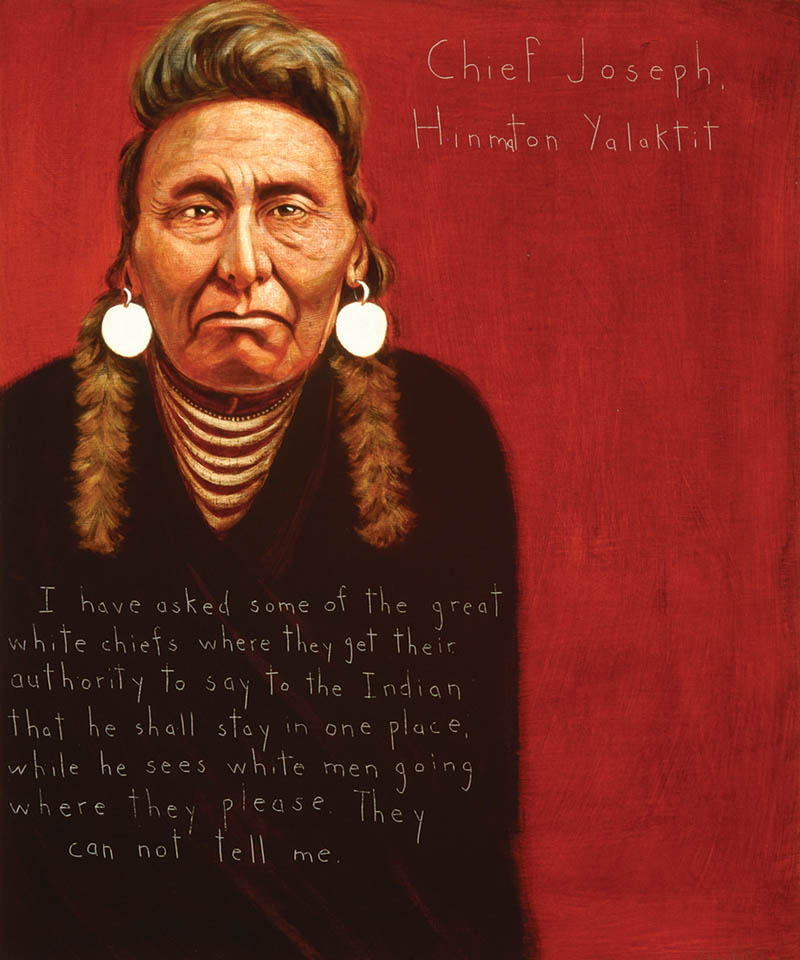
Chief Joseph, Hinmatóowyalahtq̓it
Native American Leader : c. 1840—1904
“I have asked some of the great white chiefs where they get their authority to say to the Indian that he shall stay in one place, while he sees white men going where they please. They cannot tell me.”
Biography
Son of a Nez Perce Indian chief, Joseph was born Hinmatóowyalahtq̓it (“Thunder Rolling Down the Mountain”) on land that is identified today as being in northeastern Oregon. He became known as Joseph the Younger because his father, one of the first Nez Perce to convert to Christianity, earlier had taken Joseph as his baptismal name.
In 1863, following a gold rush, whose white participants entered the territory of the Nez Perce, the federal government claimed some six million acres of tribal land. Joseph the Elder renounced both the United States and Christianity. When he died in 1871, his son became chief and soon had to deal with a very difficult choice.
When a U.S. general threatened a cavalry attack in 1877, Chief Joseph at first agreed to take his people, now diminished in size by ninety percent, to a reservation in Idaho. Before this could happen, however, a group of young Nez Perce warriors attacked white settlements along the Salmon River and then went to hide among the tribe. Joseph, who initially had believed that resistance to the U.S. military would be futile, was forced to resist. Moving north through the mountains of Idaho, Wyoming, and Montana, the Nez Perce, under his leadership, conducted one of the most brilliant retreats in American history. In a little more than three months, this band of seven hundred, with fewer than two hundred warriors, traveled almost fifteen hundred miles while fighting off a pursuing army of two thousand.
By the time the exhausted, starving Nez Perce were forced to surrender in early October 1877, just forty-two miles from the Canadian border, Joseph had become famous, and was called “the Red Napoleon.” In truth, his younger brother, Olikut, and others were the war leaders of their tribe, while Joseph was responsible for guarding the camp. Chief Joseph, however, is best remembered today for his elegant surrender speech, which has been called the most famous statement in Native American history. It ends, “Hear me, my chiefs; my heart is sick and sad. From where the sun now stands, I will fight no more forever.”
Chief Joseph had been told that his people would be returned to their lands in Oregon, but instead they were transported to eastern Kansas, and then Oklahoma, where many died from epidemic diseases. He continued to protest their treatment, even traveling to Washington D.C., in 1879 to meet with President Hayes, but he and the Nez Perce were never permitted to return to their homeland. He died in northeastern Washington State in 1904 and was buried there in exile.
Programs
Americans Who Tell the Truth (AWTT) offers a variety of ways to engage with its portraits and portrait subjects. Host an exhibit, use our free lesson plans and educational programs, or engage with a member of the AWTT team or portrait subjects.

Education
AWTT has educational materials and lesson plans that ask students to grapple with truth, justice, and freedom.

Exhibits & Community Engagement
AWTT encourages community engagement programs and exhibits accompanied by public events that stimulate dialogue around citizenship, education, and activism.